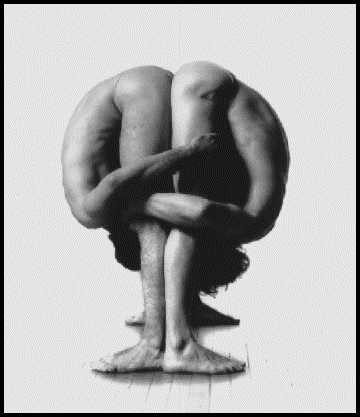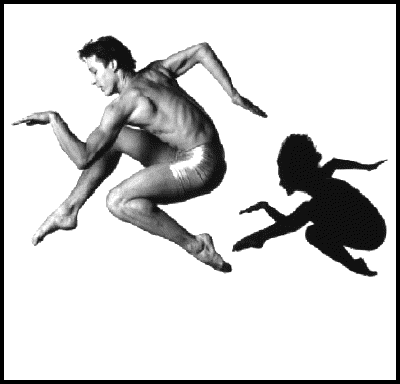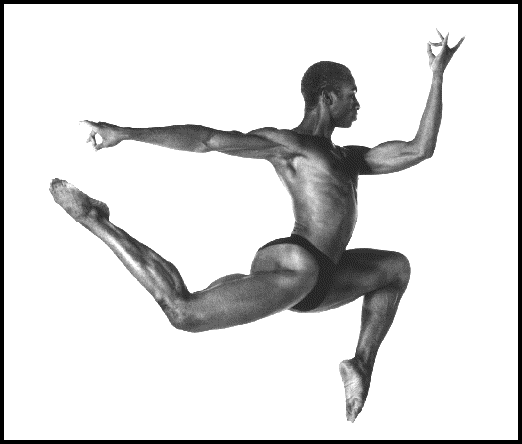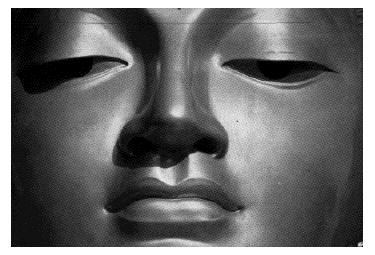The New Dance
Photography
Of Lois Greenfield
Designed by William A. Ewing
(Chronicle Books)
 Lois Greenfield specializes in stark black-and-white photographs of dancers. But it's not ballet members, locked in rigid steps, in tutus. Better ... it's dancers suspended (through the magic of photographs) in mid-air, human figures reflected back on each other, shadows and moves that --- for this reviewer --- redefine bodies ... elegant bodies.
Lois Greenfield specializes in stark black-and-white photographs of dancers. But it's not ballet members, locked in rigid steps, in tutus. Better ... it's dancers suspended (through the magic of photographs) in mid-air, human figures reflected back on each other, shadows and moves that --- for this reviewer --- redefine bodies ... elegant bodies.William Ewing, the book's designer, states that in his visit to one of her shooting sessions, he expected that he would see that "the dancers appear to have lifted themselves into the air, waited for the photographer to snap the shutter."
It was not so, for
I could see nothing in front of me that remotely resembled a Greenfield image; all I saw were heavy, sweating bodies thudding about, the strenuous movements accompanied by sharp exhalations of breath as they landed.
"I watched the dancers repeat each take with minor variations according to Greenfield's directions but the action never seemed to coalesce into the elegant, ordered motif I was expecting."
There are over 100 shots in Airborne, and they not only redefine bodies, they do the same to the art of dance, and the art of photography. We might say that what we have here are "motion pictures" --- Greenfield stretching the art of still-life (and still life photography) so that there is in the images a powerful frozen motion that --- at times --- seems to make the dancers dance right off the page for us. The dancer and the dance become as one.
 Greenfield started out twenty-five years ago as photographer for The Village Voice, Rolling Stone, Time and Newsweek --- but it was her work for Dance Magazine that brought her into this new world of plastic form.
Greenfield started out twenty-five years ago as photographer for The Village Voice, Rolling Stone, Time and Newsweek --- but it was her work for Dance Magazine that brought her into this new world of plastic form.
William A. Ewing and Daniel Girardin, in their commentary, take us through the evolution of Greenfield's work --- from working for others, then participating in "a whole new vocabulary and grammar of dance..." Once she set up her own studio, she began work on her own. According to the editors, in this work, she has established six styles of photography --- including "the attributes of a dancer," the use of "literal choreographic material," and full improvisation. As one goes through Airborne, it seems that these categories might well be a bit arbitrary, but...no matter. What Chronicle Books has created here with Ms. Greenfield is a whole new vocabulary of dance, of black-and-white photography, of motion, of the frieze (read the "freeze") of elegant bodies, of a unity of form and function that goes well beyond description.
Some of us, for various reasons, are not too interested in people "jumping around on the stage to the music of Tchaikovsky," as one critic described it. But to see these sinuous creations, moving so stunningly about on the page is to experience a model that defies the old concepts of "dance" and "ballet."

This is not to say that those who publish their own works have to be wretched writers: after all, Virginia Woolf and Walt Whitman --- to name two --- were responsible for their own works seeing the light of day. But when we get five or so books a week (major newspapers get 300 - 500) it's easy, too easy, to overlook those that were paid for by the author. Therefore it is a surprise, and a pleasant one, to run across something like Daring to Write. Marianna Ruybalid is disabled with cerebral palsy. Her poems can be touching --- as much as for what is said, as for what is not said: To table is to decide to deal later, I need to table my decision about suicide. Ruybalid views her life (and her disability) with complete honesty; her vision of her self, her body, and her life (and her wish to be out of it) is unflinching; her poems have the understatement that makes one want to read more: You're hopeless, you can do nothing. Stop And then, But razors tell me to take ten valium
We would hope that Ms. Ruybalid would work to make her poetry a bit more ... well, poetic. That is, not to use end-stops thrown in there willy-nilly; to develop more natural breaks; to work on structure. We would also hope that she would be able to follow strong lines like I am trapped and alone. with ones that don't seem to be a parody; e.g., ...I want white wine's gentle doom. In all, her writing is terse, vigorous, and well worth it.
Write
Mariana L. Ruybalid
(University Editions)
The table has four strong legs,
blue and white checked oil cloth,
and a bright yellow jar from Costa Rica.
I eat breakfast sitting in the sun.
Today I will buy some flowers.
not sweeping in under the rug, but later.
Now I will go to College Avenue and
buy red carnations for the yellow jar.
While I pass thought this time of rage,
perhaps even going down deep through despair,
I put the decision and the yellow jar of red flowers on the table.
the pain by killing yourself! Stop the curse!
Stop men touching you there! Stop the
violation of your mind and body! Cut your
wrists! Die!
To get even for people leaving me.
I take ten so I won't vomit them up.
My hands clench. I drool...
Fly zoom, to the moon.
No, it asks a discipline that is far more difficult. It asks that we shut up the babbling headtalk. Make the brain-pan stop its endless torrent of memories dreams reflections angers loves hates strife wondering plans hopes and fears. Furthermore --- and as difficult --- Buddhism demands that we begin to quell the passions of the flesh, be kind to all living creatures, and --- probably the most difficult of them all --- be gentle to ourselves. If we fail, if we continue to misuse this life in manipulation, greed, envy, and lust, if we fail to clear the mind of its daily sludge of desire, regret and scheming, if we continue to give pain to others (in any form whatsoever) --- they have a special penalty for us. It is not a murky hell, with pitch-forks, fire and sulphur, bodies flaming in the stygian charnel-pits of brimstone for a mere eternity. No, they have something far worse. For if we fail to set ourselves on the path, kindness to all sentient beings, calm and love for self --- they are going to make us come back and do it all over again. We will be forced to return --- not once, but many times, to live out other lives, here on earth. Other eternities of hag-ridden, bone-aching, soul-wrenching misery-and-woe pain-and-disease lifetimes, countless centuries, back again on earth. Yet again. And again. And even yet again.
Until we finally get it right.
Try to prove that this scenario of the Buddhists is a kinder, more gentle vision than the one of dancing devils with pitchforks, in the smoke-filled pits of hell. Just try to prove it.
For anyone starting out on this difficult (some would say almost impossible) path, Buddhism for Everyone is an appropriate guide. It is short, to-the-point, and written in none but the simplest language. "Buddhism is a religion and a philosophy," Nairn writes, "but most of all, it is a way of life." He takes us through the history of Buddhism, and offers four of the most salient demands that it makes of us: Nairn claims that our "condition of distraction" is so customary that we have to use other means --- television, music, movies, alcohol, this computer I'm writing on right now --- to distract us from our distraction. The freedom that comes from recognizing the three distractions and distancing ourselves from them is not quick, but as it begins to come, it will create what he calls "the strong mind: a mind that is capable of remaining totally in the present moment without deflection or distraction." Excellent lessons for those who wish to begin what they call "the practice" of Buddhism.
Meditation?
Buddhism for
Everyone
Rob Nairn
(Shambhala)

The author describes the three main schools of Buddhism, then offers a how-to-do-it on meditation and the quieting of the babbling mind. He defines the three distractions that haunt most of us, namely --- yesterday, today, and tomorrow, distractions guaranteed to give the most difficulty to those who are trying to shut up what the Tibetans call "the waterfall:"